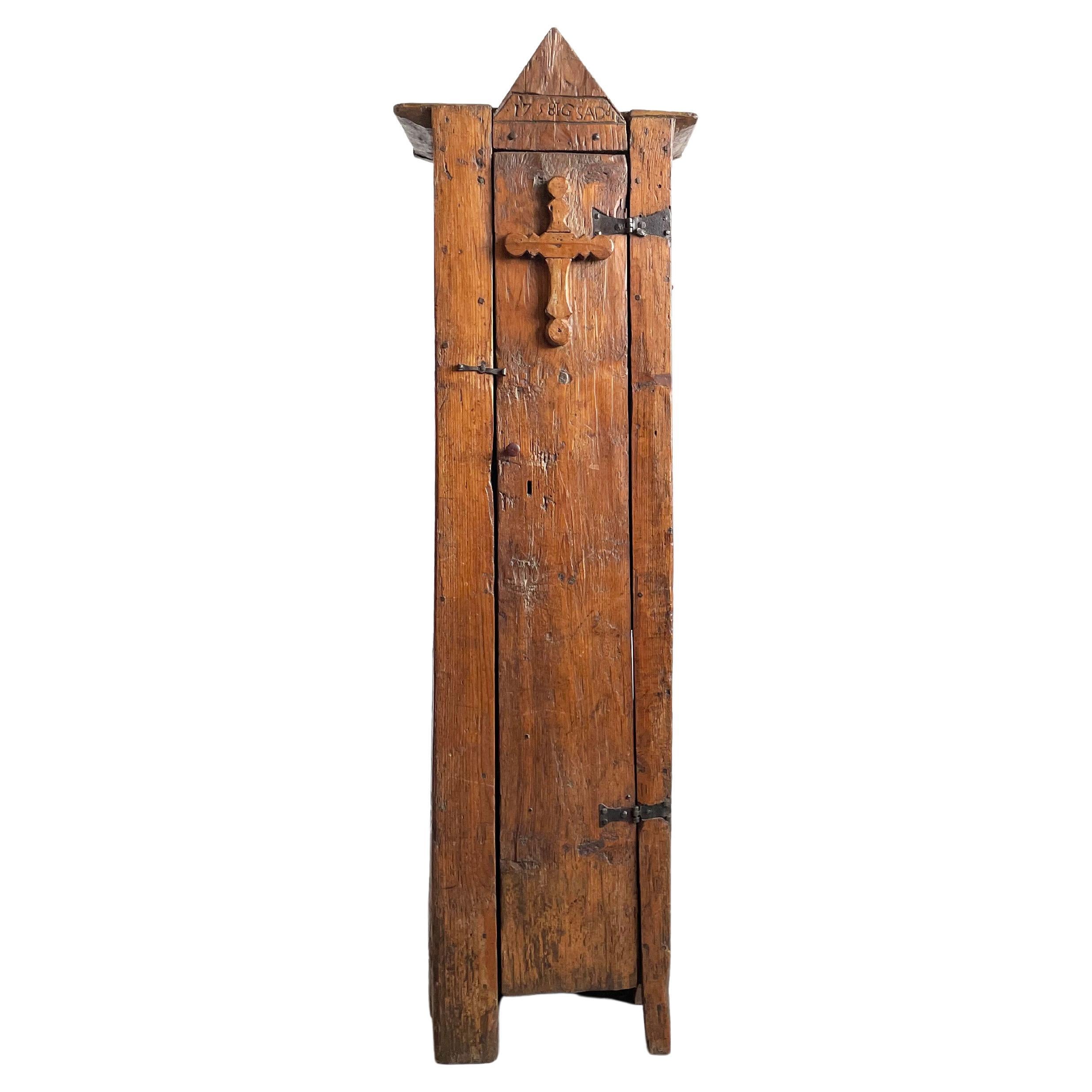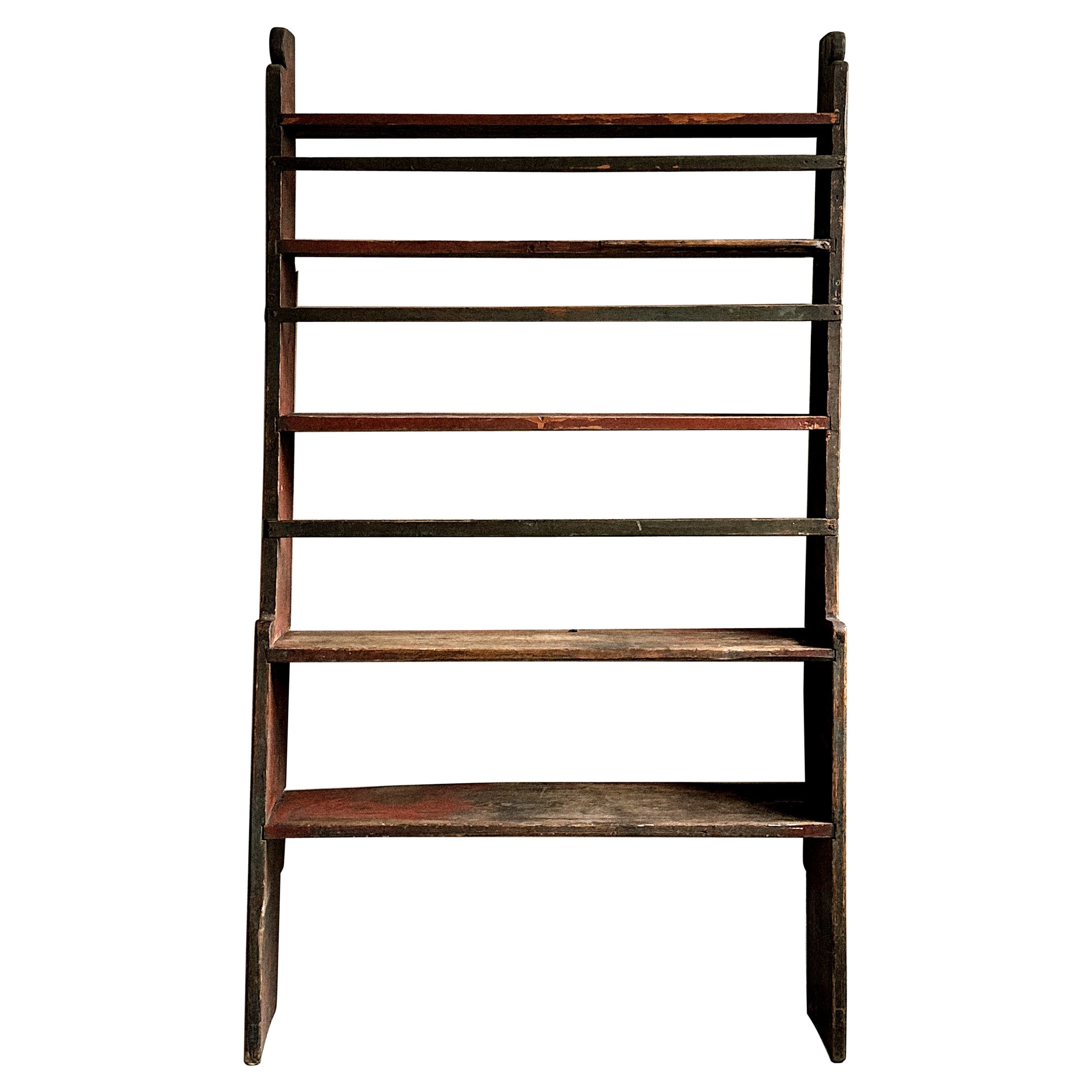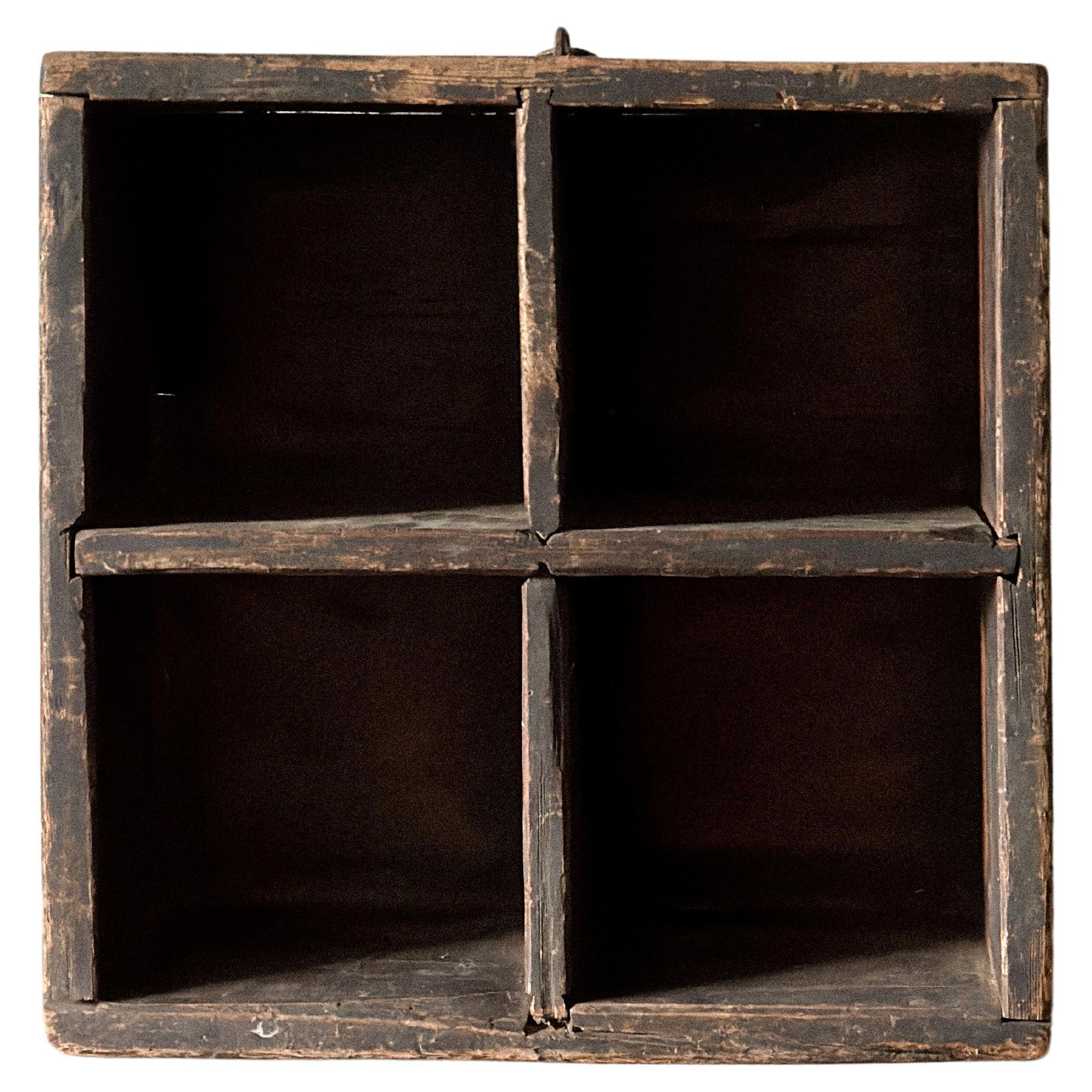Items Similar to A magnificent Dutch marquetry cabinet on stand, by Jan van Mekeren (1658-1733)
Want more images or videos?
Request additional images or videos from the seller
1 of 5
A magnificent Dutch marquetry cabinet on stand, by Jan van Mekeren (1658-1733)
About the Item
A magnificent Dutch marquetry cabinet on stand, by Jan van Mekeren (1658-1733) possibly made for William III and Mary of England
Amsterdam, circa 1687
The oak cabinet is decorated with 'arabesque' or 'seaweed' marquetry in Turkish walnut (Juglans regia) on a holly (Ilex aquifolium) font, surrounded by a kingwood (Dalbergia cearensis) border. The top has a modest rectangular cornice of a frieze over two doors revealing the interior fitted with four shelves and five drawers. The inside of the doors and the drawer fronts are veneered with plain cedar (probably Cedrus atlantica). The stand has a frieze drawer and is raised on six S-shaped legs, joined by shaped stretchers and raised on turned ball feet. The entire cabinet, from the cornice to the stretchers, is covered in marquetry.
H. 209 x W. 178 x D. 67 cm
Provenance:
King William & Queen Mary of England or their very close circle, thence by descent (possibly)
Noble collection, England
Literature:
Monique Riccardi-Cubitt, Art of the Cabinet, Thames & Hudson, London, 1992, ill. p. 96 (as English, c. 1695)
The stellar feature of this cabinet is the fine marquetry, which shows scrolling vines, plants, and fruits, clearly recognisable but abstract. The latter’s design was not chosen randomly, for it is filled with symbolism specific to the marriage between William of Orange and Mary Stuart. The letters M and W can be found above each other on each side of the cabinet, with vines and leaves forming a heart in between, praised on each side by a narcissus (a spring flower symbol of new beginnings), placed within a giant thistle. W is in the centre of the cartouche, but M is not. When the M is noticed, one will also see the thistle.
Further, the well-known symbols for the House of Orange, recognisable by many in the Netherlands, have prominent places on the cabinet, such as the Appeltjes van Oranje, which are oranges and their blossom (recognisable because it is the only plant bearing fruit and blossom at the same time); roses for England, olive branches, a symbol of peace and stability (a result of the alliance between England and Holland); thistles (the symbol of the House of - Mary - Stuart, and Scotland); mistletoe, growing in pairs of branches and leaves (stands for being a couple) and is evergreen (for eternity); hazelnuts for fertility; and sunflowers for the transitoriness of/ and kinship.
Today we can’t comprehend that 17th-century people would immediately understand the symbolism. However, sources prove that myths and symbolism were part of education and shared knowledge, at least amongst the literate and educated upper class. With the intricate decoration, a cabinet like this would be a good enough conversation piece for William’s and Mary’s status. After all, a generic one with just a geometric motif was for ordinary people. On the other hand, a cabinet with custom-made iconography would be most entertaining to guests in a candle-lit drawing room. You can imagine a company chatting about the different flowers and their meanings. Another argument for the symbolism being not hidden is a bureau in the Royal Collection Trust, which Gerrit Jensen delivered (in whose studio Van Mekeren worked) in 1690 to William and Mary. The decoration holds the same flora and symbolism as this cabinet, the only difference being a clear monogram with a crown above. The symbolic plants and flowers are just as present on the cabinet, but with a monogram, showing that they were not hidden on both pieces. There is also a gueridon known, not documented, but by repute in the United Kingdom, with the same decoration.
All these symbols, together with the lion and eagles, are seen on the portrait of the young William III by Jan Davidsz de Heem and Jan Vermeer van Utrecht and on an engraving by Pieter van Gunst after Jean Henri Brandon and the designer seems to have used this image for the decoration of this cabinet.
Even more plants with meanings can be identified and combinations intended to be made, which could reveal even more spectator-specific intentions. Unfortunately, much of the meaning of the 17th century and earlier symbols has been lost or has yet to be studied.
Jan van Mekeren had six children with his wife, Maria. He had intended for his first son Fikko, born in 1693, to succeed him as a cabinetmaker, but unfortunately, Fikko died in 1731. After Jan’s death in 1733, the wood trade was continued by his daughter-in-law, but there was no one able to continue his cabinet-making business. Despite a 1624 regulation stipulating members of the Amsterdam cabinetmaker’s guild who offered their wares for sale in the guildís shop, furniture makers in 17th and 18th century Holland hardly marked their work. However, thanks to the inventory after Jan’s death, there is a good list of his workpieces with thorough descriptions, prices, and the names of his clientele.
The estate included many finished and unfinished pieces of furniture, an extensive collection of cabinet woods, and, most interesting, a long list of claims with names of the debtors and the amounts due. Most debtors were well-known Amsterdam patricians.
This cabinet is officially the eighth documented cabinet entirely attributed to, and thus by, Jan van Mekeren. The cabinet’s construction is nearly identical to that of the Van Mekeren Cabinet already in our collection, but also to that of the cabinet in the Rijksmuseum. The construction of the doors is still original and identical to that of the Rijksmuseum. Furthermore, some parts of the marquetry design on the doors and the central marquetry at the front and sides of the frieze are the same as the design on other cabinets by Van Mekeren.
- Creator:Jan van Mekeren (Cabinetmaker)
- Dimensions:Height: 82.29 in (209 cm)Width: 70.08 in (178 cm)Depth: 26.38 in (67 cm)
- Materials and Techniques:
- Place of Origin:
- Period:
- Date of Manufacture:1687
- Condition:Repaired: some veneer losses filled in. Wear consistent with age and use.
- Seller Location:Amsterdam, NL
- Reference Number:1stDibs: LU5458233730122
About the Seller
5.0
Vetted Seller
These experienced sellers undergo a comprehensive evaluation by our team of in-house experts.
Established in 1985
1stDibs seller since 2020
19 sales on 1stDibs
Typical response time: 3 hours
- ShippingRetrieving quote...Ships From: Amsterdam, Netherlands
- Return PolicyA return for this item may be initiated within 7 days of delivery.
More From This SellerView All
- Highly Important Dutch Floral Marquetry Cabinet by Jan van Mekeren, circa 1700By Jan van MekerenLocated in Amsterdam, NLThe Van Mekeren cabinet: A Newly Discovered Pinnacle by the Master of Marquetry The highly important Dutch marquetry Van Mekeren cabinet Amsterdam, circa 1700, by Jan van Mekeren...Category
Antique Late 17th Century Dutch Cabinets
MaterialsWood, Hardwood, Fruitwood, Kingwood, Nutwood, Oak, Pearwood, Tulipwood
- 17th Century Dutch-Colonial Indonesian Sono Keeling Foliate Cabinet on StandLocated in Amsterdam, NLAn Indonesian Sono keeling or Javanese rosewood foliate cabinet on stand or Rankenkast Jakarta (Batavia), late 17th century Measures: H 173 x W 133 x D 51 cm The front of this cabinet is decorated with three carved swags of fruits and flowers coming out of cherub’s heads, a long drawer under two doors and two shelves behind the doors. Usually, this type cabinet...Category
Antique Late 17th Century Sri Lankan Dutch Colonial Cabinets
MaterialsRosewood
- Magificent Dutch 'Daniel Marot' Baroque Walnut Burr Cabinet on Stand, circa 1720By Daniel MarotLocated in Amsterdam, NLThe Marot cabinet A Magnificent Walnut Burr Cabinet on stand or 'kruisvoetkabinet' in the style of Daniel Marot Circa 1720, probably made for George Clifford III in Amsterdam or the Hague The cabinet is one of the rarest examples of a so-called Kruisvoetkabinet, which is translated to Cabinet on stand. The cabinet is raised on a stand with eight legs and tree drawers. Below the drawers and on the sides are five carved ornaments. The hollow formed corners are mounted with carved ornaments too. The upper part of the cabinet has two doors decorated with panels and on each door two carved ornaments in Marot style. The cabinet has a double dome top.The interior of the cabinet has tree shelves and five drawers. The brass fittings and handles are original and finished with gilt lacquer. The cabinet is made of oak and veneered with burr walnut. The carvings, turned parts and the ball feet are made of solid walnut. This cabinet is a unique piece of Dutch furniture. Cabinets on stand became popular in the third quarter of the 17th century and were made until the second quarter of the 18th century. Most of the dutch cabinets on stand...Category
Antique Early 18th Century Dutch Louis XIV Cabinets
MaterialsOak, Walnut
- Traditional Ashanti African Chief’s velvet and gilt-wood Leopard crown on standLocated in Amsterdam, NLA traditional Ashanti Chief’s velvet and giltwood Leopard crown Ghana, early 20th century Diam. 17 cm (crown) H. 27 cm (incl. stand) Provenance: Private collection, Paris The s...Category
Early 20th Century Ghanaian Antiquities
MaterialsVelvet, Giltwood
- William & Mary Seaweed Marquetry Inlaid Cabinet by Gerrit Jensen (c. 1634-1715)By Gerrit JensenLocated in Amsterdam, NLAn Anglo-Dutch William and Mary Seaweed Marquetry cabinet on stand by Gerrit Jensen, Royal Cabinetmaker England, circa 1690 The cabinet is c...Category
Antique Late 17th Century British William and Mary Cabinets
MaterialsBrass
- Rare Dutch Maternity or Child's Cabinet, in Dutch 'Luiermandskast', circa 1650By Herman DoomerLocated in Amsterdam, NLA rare Dutch Renaissance 17th-century Maternity room or Child's cabinet, in Dutch called 'Luiermandskast' circa 1650, possibly the circle of Herman Doomer...Category
Antique Mid-17th Century Dutch Renaissance Cabinets
MaterialsEbony, Oak
You May Also Like
- 19th Century Black Forest Carved CabinetBy Black ForestLocated in Coeur d'Alene, IDSwiss carved china cabinet. Front door has bear paying accordion. Mother and father dancing together as cub plays close by. Two bears supporting shelves. Two drawers for flatware. Be...Category
Antique Early 1900s Swiss Black Forest Cabinets
MaterialsWood
- 18th Century Primitive Folk Art Baroque Era Unique Pine Cabinet Chimney CupboardLocated in Zagreb, HRStunning sculptural piece of furniture, a rustic wabi sabi folk art primitive cabinet, "chimney cupboard", from the 18th century. One of a kind antique rustic piece with loads of...Category
Antique 18th Century European Folk Art Cabinets
MaterialsWrought Iron
- Antique Pine Book Shelf, Wabi Sabi , Scandinavia 1800sLocated in Hønefoss, 30Beautiful antique book shelf in pine. Handcrafted by a Norwegian cabinetmaker in the mid 1800s. A great vintage book shelf with a lovely patina. Should be attached to a wall to ensu...Category
Antique 19th Century Norwegian Romantic Cabinets
MaterialsPine
- Wood and Glass MailboxLocated in Chicago, ILEight door wood and glass mailbox. Free standing or wall mountable.Category
Vintage 1920s Italian Cabinets
MaterialsGlass, Wood
- Antique Wall Unit, Wabi Sabi, Original Black Paint, Scandinavia 1800sLocated in Hønefoss, 30Beautiful wall unit in pine. Handcrafted by a Swedish cabinetmaker in the mid 1800s. A great wall shelf with a lovely patina. Original black paint. A unique rustic piece that fit...Category
Antique 19th Century Swedish Romantic Cabinets
MaterialsPine
- Wabi Sabi Antique Pine Book Shelf, Scandinavia 1800sLocated in Hønefoss, 30Beautiful antique book shelf in pine. Handcrafted by a Swedish cabinetmaker in the mid 1800s. A great vintage book shelf with a lovely patina. Orig...Category
Antique 19th Century Swedish Romantic Cabinets
MaterialsPine
Recently Viewed
View AllMore Ways To Browse
17th Century Dutch Marquetry
17th Century Dutch Marquetry Cabinet
Stuart Ball
17th C Lion
William And Mary Bureaus
William Mary Bureau
Circle Shelves
17th Century New England
Trapezoid Pendant Light
50s Partition
Antique French Empire Bench
Art Deco Mirror Ball
Caviuna Dining Table
Fauteuil Bergere Xv
Sherry Bottle
Tung Table
Carved Tufted Headboard
Hove Mobler Chair





